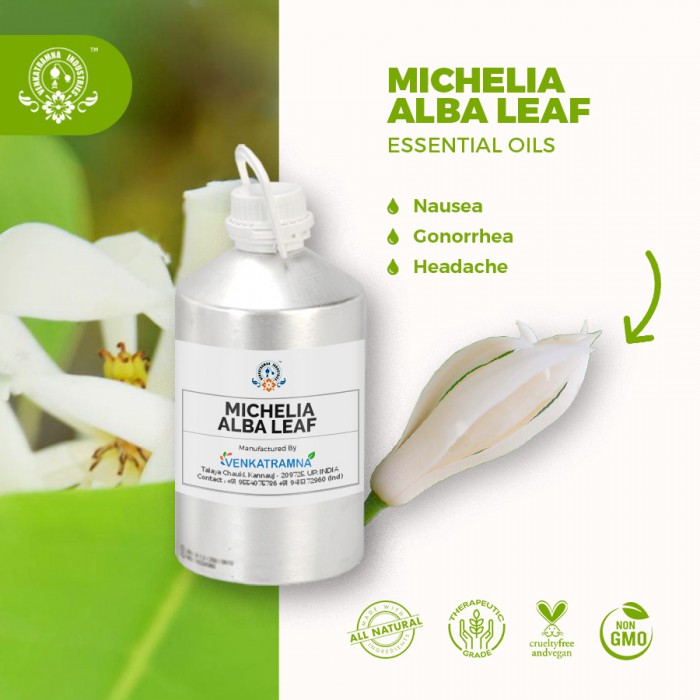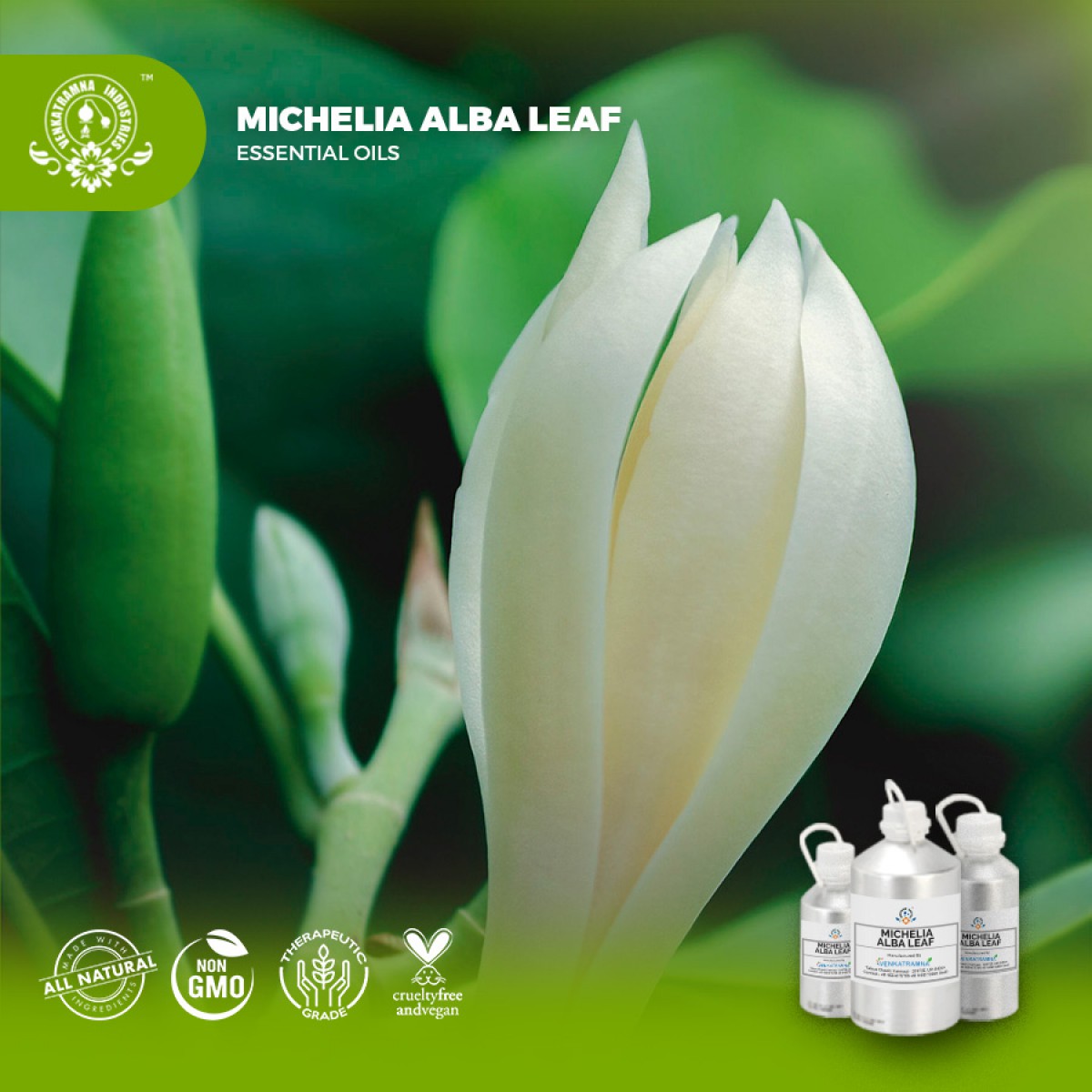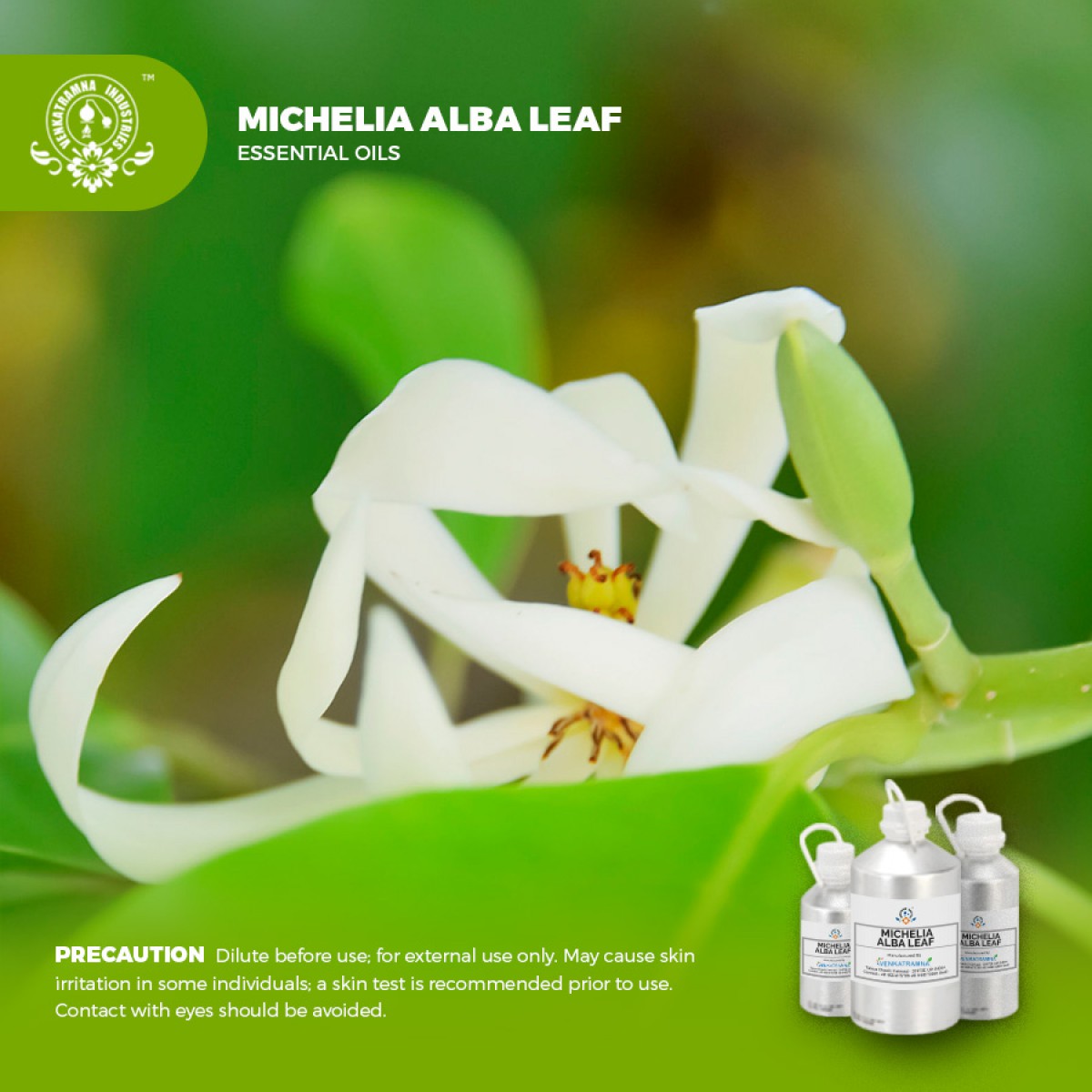Botanical Name: Michelia Alba Common name: Cempaka Putih, White Champaca, Chemp Read More
|
Botanical Name: |
Michelia
Alba |
|
Common
name: |
Cempaka Putih, White Champaca, Chempaka Puteh, Chempak,
Magnolia, White Jade Orchid Tree, White sandalwood, |
|
Plant
family: |
Magnoliaceae |
|
Genus: |
Michelia |
|
Appearance/Color: |
A thin, pale yellow to orange liquid |
|
Odor: |
A top note with a
strong aroma, Michelia Alba Essential Oil has a fresh, slightly green minty
scent that has been described as exotic with a hint of the tropical, with
bittersweet notes. |
|
Blends With: |
Basil, Bergamot, Cedarwood, Eucalyptus, Lemon, Lime, Mandarin,
Neroli and Petitgrain |
|
Origin: |
China |
|
Source: |
Leaves |
|
Method
of Extraction: |
Steam
Distillation |
Michelia champaca is native to the Philippines
and the Indonesian islands, but now also grows in places far west of its origin
- India, southeast China, Réunion, and Madagascar; the flowers are a beautiful
deep orange-yellow borne on a medium-sized slender tree related to the
Magnolias.4 In many areas where it thrives, the flowers are used for ornamental
purposes and for worship in temples.
It is a fast growing medium-sized
tree with an upright habit and attractive lime-green foliage. The lovely,
orchid-like, highly fragrant, white flowers appear from mid Spring through to
Autumn. Moist, well drained situations are preferred in full sun to partial
shade. Mulch well to keep surface roots cool, and water regularly during
Summer. Paklan will thrive in subtropical areas, but can be grown from Cairns
to Tasmania and tolerates light frost to -4 degrees Celsius. This tree responds
well to pruning and its narrow, upright form makes it an excellent specimen
tree for medium to large gardens or parks.
In Theravada Buddhism, champaca is said to have used as the tree for achieved enlightenment, or Bodhi by seventeenth Lord Buddha called "Aththadassi. According to Tibetan beliefs, the Buddha of the next era will find enlightenment under the white flower canopy of the champaca tree.
DISCLAIMER
The complete range of conditions
or methods of use are beyond our control therefore we do not assume any
responsibility and expressly disclaim any liability for any use of this
product. Information contained herein is believed to be true and accurate however,
all statements or suggestions are made without warranty, expressed or implied,
regarding accuracy of the information, the hazards connected with the use of
the material or the results to be obtained from the use thereof. Compliance
with all applicable federal, state, and local laws and local regulations
remains the responsibility of the user.
The FDA has not evaluated the
statements on this website. No claims are made by Venkatramna Industries as to
the medicinal value of any products from vriaroma.com or by us. The information
presented here is for educating our customers about the traditional uses of
essential oils and is not intended to diagnose, treat, cure, or prevent any
disease. You are responsible for understanding the safe application of these products.
If you have any questions, please call or email us for further information.
As per NAHA guidelines, New Directions Aromatics
(NDA) does not recommend the ingestion of essential oils. It is imperative to
consult a medical practitioner before using Essential Oils for therapeutic
purposes. Pregnant and nursing women and those taking prescription drugs are
especially advised not to use this product without the medical advice of a
physician. The oil should always be stored in an area that is inaccessible to
children, especially those under the age of 7.
Being it's a vital healthful
plant in Indian medication this are supposed to vary medical specialty
activities like antipyretic, analgesic, anti-inflammatory, antihelmintic,
anticancer, antihyperglycemic, antiulcer, antimicrobial, wound healing,
antioxidant and antifertility activities. Different active constituents such as
alkaloids, saponins, tannins, sterols, flavonoids, triterpenoids, michelia-A,
liriodenine, parthenolide and guaianolides, methyl linoleate, methyl
anthranilate, stigmasterol and 3?-16?- dihydroxy- 5-cholestene-21-al are a unit
to date according in Michelia champaca.
Its seductive and beautiful
fragrance produces a celestial atmosphere that soothes, relaxes and strengthens
the mind after a stressful day. Conventionally it is widely used in both
Ayurveda and Siddha medicine. It is being used in fever, colic, leprosy,
post-partum protection3 and in eye disorders4 . Juice of the leaves of Michelia
champaca is given with honey in cases of colic. The flower oil is useful in
cephalalgia, opthalmia and gout5 . The bark is used as a stimulant,
expectorant, astringent and febrifugal properties6 . The dried root and roots
bark, mixed with curdled milk, is useful as an application to absecesses,
clearing away or maturing the inflammation. In the form of an infusion it is
valuable emmenagogue. It is also considered purgative. Root and bark are used
as purgative and in the treatment of inflammation, constipation and
dysmenorrhea. The flowers and fruits are considered stimulant, antispasmodic,
tonic, stomachic, bitter and cool remedies and are used in dyspepsia, nausea
and fever.
The Magnolia Oil is widely used
in perfumes, bath oils, shower gels, anointing blends, potpourri, facial steam
treatments and hair treatments or masks, incense, room fresheners, scented
candles and other aromatic products. When used topically, It is thought to
increase the elasticity of the skin, prevent scarring and heal skin
irritations. Its overall cleansing effect and its ability to support a healthy
inflammatory response make White Champaca/ Magnolia Essential Oil is also a
great support to the respiratory, immune, and neurological system providing
mood uplifting and stress reduction benefits.
While the properties of Magnolia Oil works to pamper the skin, the fragrance
works to promote relaxation, reduce stress, relieve depression and uplift
moods. The sweet, fruity, exotic scent of Magnolia Oil is sedating and
relaxing, but yet uplifting. Calming and soothing, this exquisite floral
essential oil is also reputed for its aphrodisiac properties.
COMMON
USAGE
·
Indigestion
·
Fever
·
Nausea
·
Gonorrhea
·
Headache
·
Gout
·
Rheumatism
Ingredients:
|
S.No |
Key Constituents |
Strength (%) |
|
1 |
Linalool |
78.9 |
|
2 |
b-Caryophyllene |
4.4 |
|
3 |
b-Elemene |
2.4 |
|
4 |
(E)-b-Ocimene |
2.3 |
|
5 |
a-Caryophyllene |
1.4 |
|
6 |
(Z)-b-Ocimene |
1.3 |
|
7 |
Methyleugenol |
0.1 |
Safety Summary
·
Hazards: May
contain methyleugenol.
·
Cautions: Not
known.
·
Maximum dermal use level
EU 0.2%
IFRA 0.4%
Tisserand
& Young No limit
·
Safety advice: Considering that 87% of magnolia leaf oil
consists of anticarcinogenic constituents, we do not consider that the 0.1% of
methyleugenol requires a use restriction of the essential oil.
Champaca essential oil is
non-toxic, non-irritating and non-sensitizing. As with all essential oils,
dilute prior to use. Avoid contact with eyes. Keep out of reach of children.
Protect from heat and light
Organ Specific Effects
·
Adverse skin reaction: No information found. Oxidation products of
linalool may be skin sensitizing
·
Reproductive toxicity: The virtual absence of reproductive toxicity
for linalool suggests that magnolia leaf oil is not hazardous in pregnancy.
Systemic
Effects
·
Acute
Toxicity: No information
found. Linalool is not toxic, but does possess enzyme inducing and sedative
properties.
·
Carcinogenic/anti carcinogenic potential: No data found. Methyleugenol is a rodent
carcinogen if exposure is sufficiently high; linalool, b-caryophyllene,
a-caryophyllene and b-elemene display anti carcinogenic activity.
·
Toxicity
o
Acute fish toxicity: LC50 / 96 HOUR – No data
available
o
Toxicity to aquatic plants – No data available
o
Toxicity to microorganisms – No data available
o
Toxicity threshold – No data available
·
Persistence and degradability: Biodegradation is
expected
·
Bio-accumulative potential: Bioaccumulation is
unlikely
·
Mobility in soil: Unknown
Avoid exposure to marine environments and waterways





 MSDS-Michelia.pdf
MSDS-Michelia.pdf




